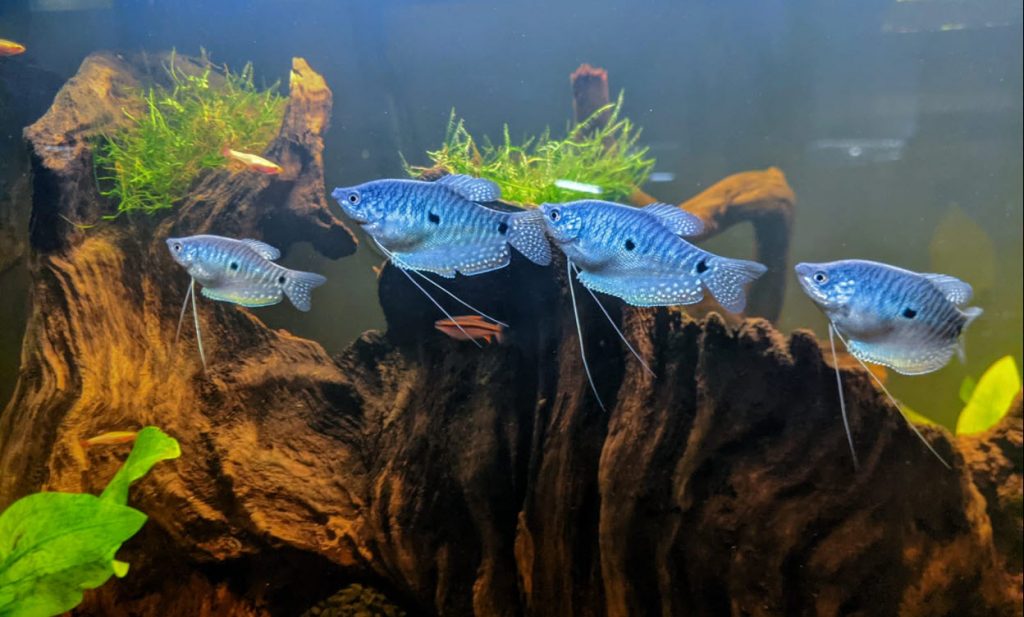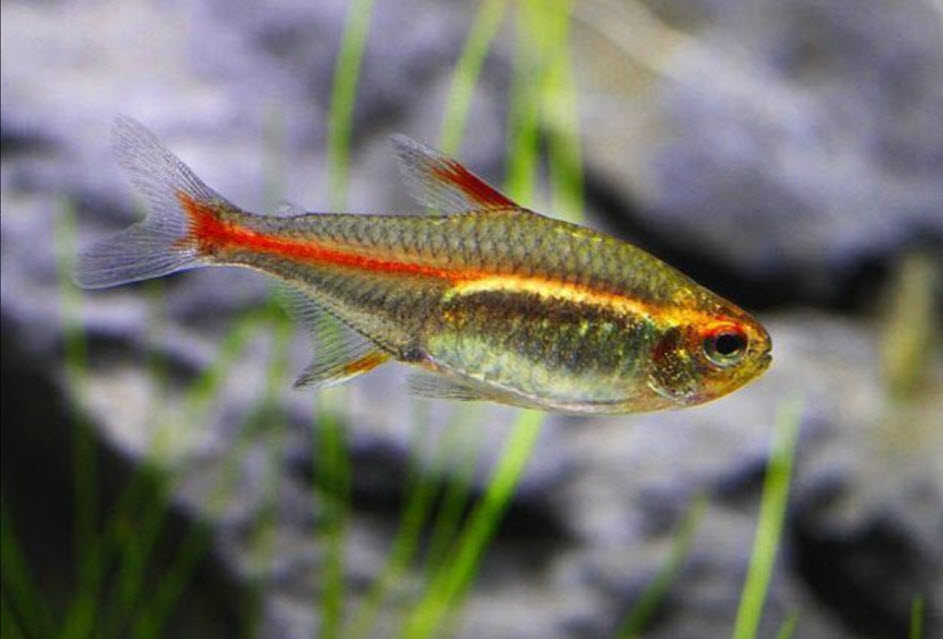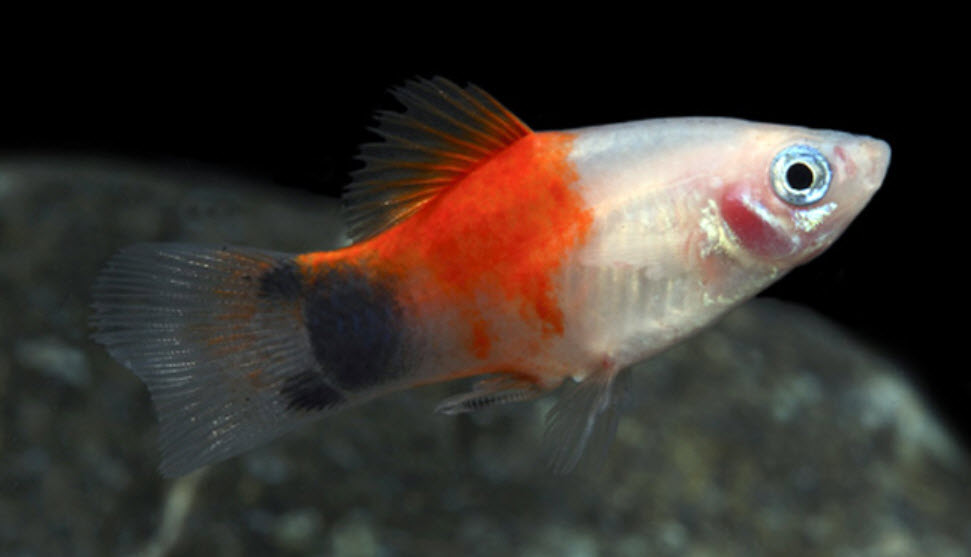
The water fish swim in is very important. But it is not nearly as important as people give it credit for. The chemistry of the water, the pH, the hardness, and the salts contained in the water, are just not very important to the well-being of the freshwater tropical fish.
.
If you can drink the water, fish can thrive in it
.
So do not buy a test kit with your new aquarium. Just add a de-chlorinator if one is on a municipal water system and GO. Add fish when you are ready. And simply do not worry about the water. The “water parameters” are just not that important.

Water Parameters in More Depth
Note EVERY time I say that water parameters are unimportant on social media the number of fish police who come out of the woodwork to say “That’s not true, you idiot” are amazing. But it is simply true! Add conditioner if the water had chlorine in it and you’re good to go. The following points are pertinent:
- The water in the aquarium needs to be as bacteria-free as possible. This requirement is important but rarely even mentioned or discussed. The bacterial count correlates with the water clarity. “Crystal clear” water is very low in bacteria while “dull” water is very high in bacteria.
- Close control and stability of temperature in NOT important. Temperature for almost ALL tropical fish can range from 70 to 90 degrees F. (21 to 32.3 degrees Celsius), with the occasional excursion to 65 degrees F (18.3 C.) to 95 F (35 C.). And fish are not “shocked” by rapid changes in temperature.
- The pH of the water is not very important. Most tap water between a pH of 6.5 and 8.5 is fine for all fish. Some fish require water like their native waters for breeding. Beneficial bacteria need a pH higher than 6.5 to process ammonia.
- Hardness (both GH and KH) is of little consequence except in that some KH hardness stops a “crash” or “old tank syndrome” from occurring. “Old tank syndrome” can’t occur if one does 50% water changes every one to four months (depends on stocking levels). Some KH is also needed during cycling the typical aquarium.
- Salts are not important so long as most fish have a little. If one has RO water they take on more significance. The only time fish can get in trouble is if a fish is put in very salt-free (total dissolved solids or TDS less than 60) water.
- The idea that water has “heavy metals” or “toxins” in it is a huge myth, propagated by those who sell products “designed to remove the heavy metals and toxins”. Isn’t the profit motive great?

Water Changes
There is a myth that one must change the water in an aquarium at least once a week. This idea is patently false. We recommend a 50% every two months to four months, depending on stocking. These “water changes” ONLY take out nitrate from the aquarium. Water changes do NOTHING else in the aquarium.
Note many very experienced hobbyists do no water changes and do just fine. There is a whole fish store in San Francisco that hasn’t done a single water change in ten years with what are probably fifty or sixty aquariums. https://www.youtube.com/watch?v=rg1u-XVMU3Q
The only reason to do water changes is to keep the nitrates low. And nitrates are just not very toxic. If one does water changes according to nitrate level I recommend water changes only if the nitrate goes above 80 ppm. Note nitrates are ONLY reduced by water changes or plants. Here is an article on it:
5.4. Safe Nitrate Levels
.

Myths About Water
There are many myths about the water in which aquarium fish live. Some of these myths are:
- It is essential one has a water test kit and that one tests the water frequently
- At least 50% water changes should be done once a week.
- It’s dangerous to the fish to “chase” pH with chemicals.
- High pH (>7.5 pH) is dropped by using organic materials such as almond leaves, beech leaves, oak leaves, peat, and/or driftwood.
- The “water parameters” shown by water test kits are important when diagnosing fish diseases.
- Fish will have their lives shortened if put in a pH different than their native waters.
- Fish from the Blackwater Amazon will suffer in water with a high pH.
- The hardness (GH and KH) of the water is very important to the fish.
- Fish will have their lives shortened if put in a water hardness different than their native waters.

- Rapid changes (in seconds) in water parameters (pH, hardness, and/or temperature) can damage or kill freshwater fish.
- Temperatures need to be closely held for healthy fish and heaters are an absolute necessity in most homes.
- Stability in aquarium parameters (temperature, pH, hardness) over hours or days is important.
- Nitrates going above 10, 20, 40 or even 80 ppm will shorten the life of an adult fish.
- Ammonia levels at some level below 5 ppm or nitrite levels below 1 ppm are detrimental in any way to fish at a pH of 7.
- Ammonia levels at 5 to 10 ppm or nitrite levels from 1 pm to 5 pm are very toxic to fish at a pH of 7.
- When shipped fish are un-bagged, they should be gradually acclimated to their new water chemistry.

- Water that has been run through a water softener is bad for fish.
- Water changes remove built-up toxins and fish hormones in the water.
- Water changes are bad because they cause variation in the water parameters.
- Primetm and Safetm are superior water conditioners that also “neutralize” ammonia, nitrite, nitrate, and heavy metals.
- There are products that “neutralize” ammonia and nitrite (Tetra AquaSafe Plus, Kordon AmQuel, ClorAm-X, Hikari Aquarium Solutions Ultimate, SeaChem AmGuard, API Ammo-Lock, API Stress Coat).
- It is beneficial to add “bacteria in a bottle” such as Stability for every water change.
.
All these myths are simply false
.

To go into the subject of Water Parameters in more depth click on the following link:
4. Water Parameters
.
Return to Guidelines for Beginners Menu
.
Aquarium Science Website
The chapters shown below or on the right side in maroon lead to close to 400 articles on all aspects of keeping a freshwater aquarium. These articles have NO links to profit-making sites and are thus unbiased in their recommendations, unlike all the for-profit sites you will find with Google. Bookmark and browse!
.

Dave says
In reply to A. H. …….. I missed that reference in Walstad. I just can’t help but think that if copper or lead were a problem in modern aquariums in houses with copper plumbing than there would be a lot more in the literature than just Walstad.
A.H. says
What about in homes with lead or copper pipes or when fertilizers are dosed heavily? She mentioned that studies show metals from those sources kill fish at a much lower amount than in humans, so drinking water is allowed to contain higher levels. Is this false? I’m no chemist. Thanks!
Dave says
Walstad fails to provide instances of where heavy metals or other “toxins” have poisoned aquarium fish. The only water supplies that have toxic levels of heavy metals are a few mountain streams that drain mine dumps. It just is a non-existent “problem”.
A.H. says
Can you elaborate or provide sources on this part: “The idea that water has “heavy metals” or “toxins” in it is a huge myth,” I’m a bit confused while reading Diana Walstad’s book. Thanks
Dave says
In reply to Daniel …. I would simply measure the nitrates and only do the water changes necessary to keep the nitrates less than 80. Easy!
Daniel Carlton says
Dave,
First off let me just say how awesome you are. Your knowledge and experience are priceless. I am a firm believer that experience is the best teacher. You actually have experience and an education with research to back up your claims. That combination got my attention. I actually stumbled upon a YouTube video of a guy who proved that seachem matrix didn’t lower nitrates. Man he took a beating in the comments. Sometimes people can be stupid. You are also correct about Kev with Kaveman Aquatics. He actually used to have his fx6 loaded up with pot scrubbers and decided to try biohome instead. Then after seachem hired him he switched to matrix. He claimed matrix lowered his nitrates. He actually did the nitrate test on camera. I admit they were lower and I questioned your claim. But Kev made a mistake. He recently moved to a new home and video taped the move. Behind his 3d background was growing a pothos plant that had been in there a couple weeks longer than the matrix in his filter. It’s the plant reducing the nitrates not the filter. He just kept it hidden all this time. I like Kev but that disappointed me.
Anyway my question is I have a 75 gallon tank with approximately 40 mbuna in it. I have read that your overstocked tanks do water changes every 3 days. I don’t have a drip system because I rent my home. I do have a water pump that I use to drain my tanks El quicko. I currently do 1 water change a week for both my tanks but my mbuna tank I was wondering if I should go back to 2 a week. Both my tanks are HEAVY filtered. My Mbuna tank has a pennplax 1500 elite canister filter, an Aquael Ultramax 1500 canister filter, and 2 seachem tidal 110’s hob. All my canister filters are now set up as you recommend with 1 basket of 20 ppm sponge, 1 basket of 30 ppm sponge, and the rest with the k1 plastic media. The Aquael Ultramax filters hold a crap ton of that k1 stuff. The 2000 on my community tank holds so much that my first order of k1 was about 4 gallons of media and in 3 Aquael baskets it held about 70% of that entire box. I ordered more lol.
So is the once a week water change good enough for my little mbuna monsters or should I go back to 2. I do an 80% water change for them. I will say after the water change they are much more active for the next few days. Oh I forgot. I have 2 wavemakers in my mbuna tank also as you recommended. The more powerful one is pointed up and the other is on the opposite side pointing into the gravel. Hope to hear from you soon!